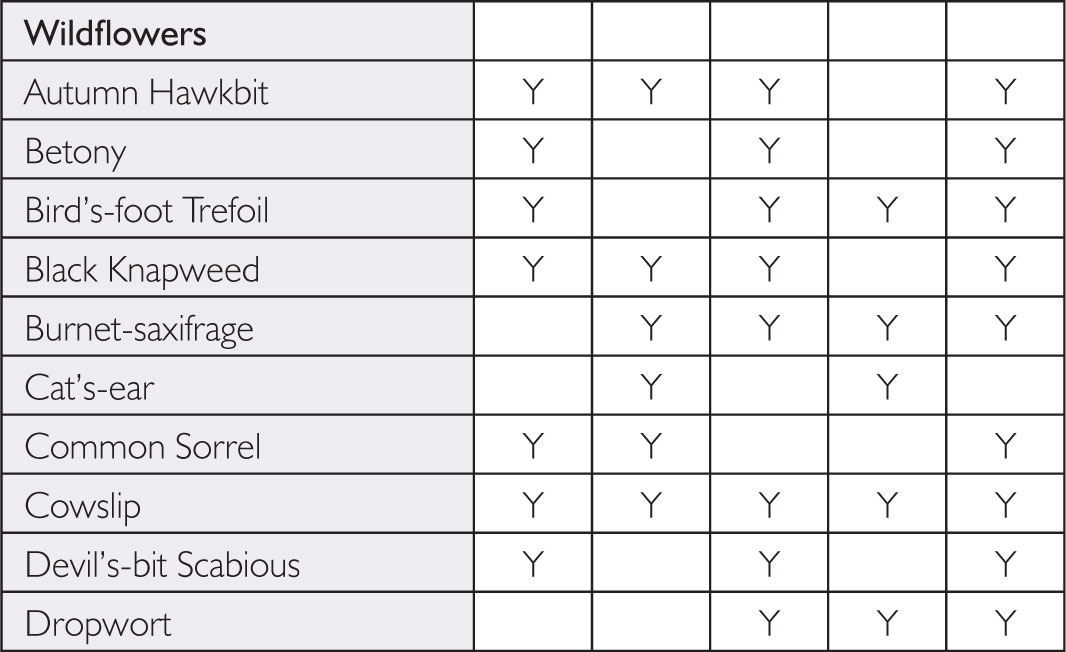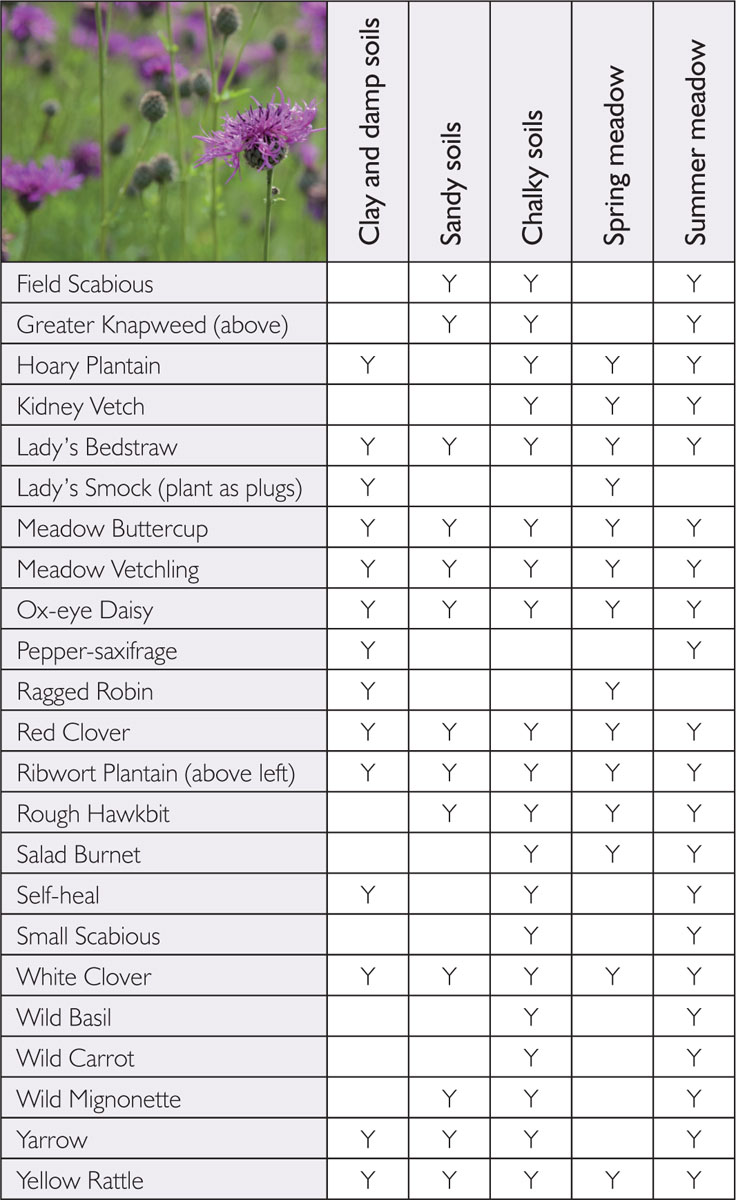
Wildflower meadows can enliven even quite small spaces, and needn’t be confined to distant parts of the garden.
Making a Wildflower Meadow Home
There’s a deep nostalgia for flower-rich meadows, provoking visions of Impressionist paintings, Merchant Ivory films and young lovers skipping through tall grasses a-buzz with butterflies, bees and grasshoppers.
OK, cut! There’s little chance of seeing a meadow like this these days. Most of the green fields out there are just monocultures of specially-selected Ryegrass cultivars that have been boosted by powerful fertilisers, sprayed with weedkillers, and cut early and repeatedly for silage.

Wildflower meadows can enliven even quite small spaces, and needn’t be confined to distant parts of the garden.
The UK’s national Habitat Action Plan for lowland meadows cites a 97 per cent loss of flower-filled pastures in the 50 years to 1984, and there has been a continued destruction since, with perhaps less than 15,000ha remaining in the UK (in a nation that covers 24 million hectares). What were some of the richest habitats for creatures, such as bugs and beetles as well as bees and butterflies, are now restricted to nature reserves and forgotten corners. Don’t blame farmers: it’s the result of advances in technology and a postwar agricultural policy demanding efficiency and productivity.
In your garden, however, you have the chance to recreate the essence of the wildflower meadows of old. They are difficult habitats to create, but don’t let that put you off. Even to do a bit will help, and it is proven to be a lifeline for wildlife such as sparrows.
KEY SPECIES
—House Sparrow
—Tree Sparrow
—Goldfinch
—Yellowhammer
—Most butterflies (including Meadow Brown – right)
—Hedgehogs
—Voles and shrews
—Many bee species
—Many moth species
—Many beetle and bug species
—Many spider species
—Many hoverfly species
—Grasshoppers
—Earthworms
—Wild meadow flowers

The inspiration
There are few wildflower meadows that have survived intact into the 21st century, but those that do are usually under conservation management, and they are well worth a visit just to admire the amazing sense of nature at her richest.
The types of wild flowers that grow, and the creatures that use them, differ according to the soil type and climate. It is as though there is not one type of wildflower meadow but a massive family of them, each slightly different. Learning these idiosyncrasies, and translating them to suit your garden, is an important tool.
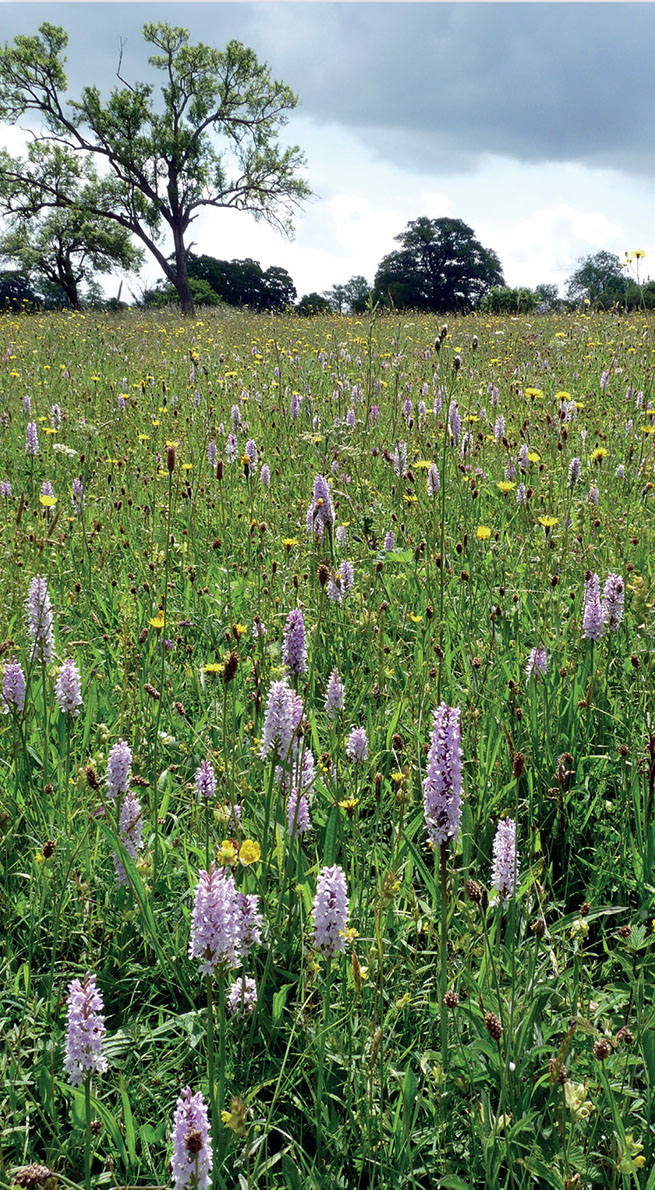
Visually, wildflower meadows are something of an informal tapestry, delightful in their randomness rather than being orderly.
Freed from the endless nibbling of animals (or mowing machines), plants throw up their flowers offering pollen, nectar and seeds to a whole range of butterflies, bees, beetles and birds.
In the wild, livestock are brought onto meadows to graze, usually in early spring or late autumn. Their hooves churn the ground a little, so that there is freshly turned soil where the seeds of annual plants such as the Yellow Rattle can germinate.
Because it is never dug or ploughed, perennial plants that don’t like being disturbed can become established. Wildflower meadows are THE place for orchids.
Unlike garden lawns, meadows contain many grass species, each with their own particular character and favoured wildlife.
Long stems create a mini jungle that is moist and shady near the ground. Down here a varied community of beetles and caterpillars tuck themselves away, and larger creatures such as voles and shrews can scurry.
After all this lushness and colour of spring, meadows then turn to summer patterns of yellowing waving seedheads, which can be just as attractive and evocative.
The poor soil means that grasses can’t dominate in the way they do when they have fertilisers to give them a boost, and the number of different flowers in a small area can be huge.
How to make a wildflower meadow
In this section I will show you two different ways to make a meadow. However, first I’m must emphasise how critical it is to understand the difference between a wildflower meadow and a bed of cornfield annuals. The latter is often called a ‘meadow’ but isn’t, and the reason why that is important is because it is created and looked after in a very different way to a real meadow.
In simple terms:
 A wildflower meadow is predominantly made up of wild grasses, interspersed with a range of mainly perennial flowers. It does best on poor soil, and is managed by mowing.
A wildflower meadow is predominantly made up of wild grasses, interspersed with a range of mainly perennial flowers. It does best on poor soil, and is managed by mowing.
 A cornfield annual mix doesn’t contain grasses and is mainly made up of (you guessed it!) annual flowers. It is fine for a rich soil, and is managed by clearing the bed each autumn, cultivating the soil and re-sowing.
A cornfield annual mix doesn’t contain grasses and is mainly made up of (you guessed it!) annual flowers. It is fine for a rich soil, and is managed by clearing the bed each autumn, cultivating the soil and re-sowing.
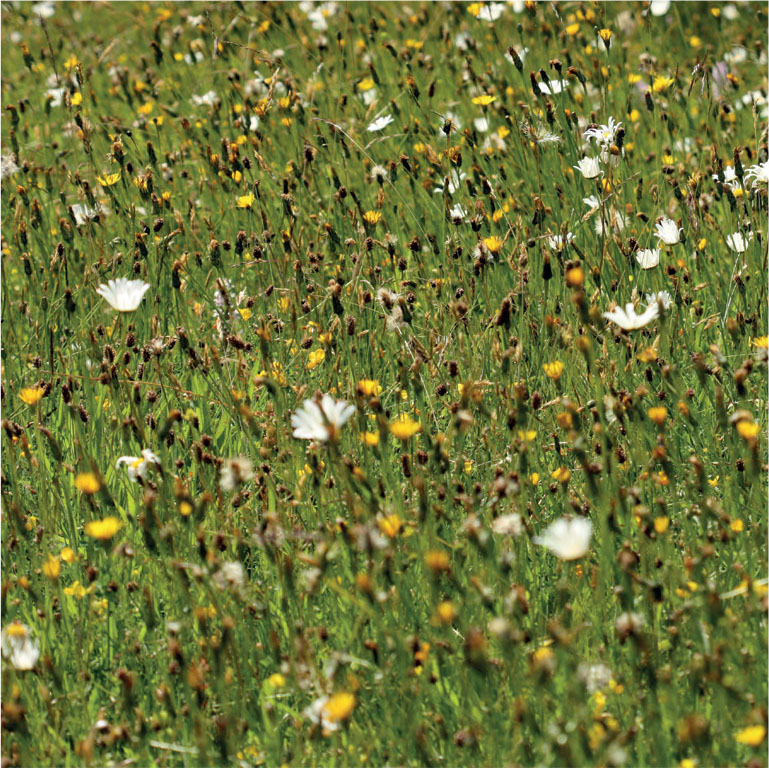
A true wildflower meadow – permanent wild grasses dotted with a myriad of mainly native perennials.
If you thought meadows were masses of poppies and other colourful flowers, you’ve come to the wrong place! Hop across to here.

This is NOT a meadow – this is a cornfield annual mix.
Meadow method 1: making from scratch
Difficulty level: Difficult, but not impossible!
This method involves taking an area, be it a lawn or flower border, right back to bare, weed-free subsoil and sowing from seed. To me, this is the A-level of wildlife gardening: take on this challenge and you can feel very proud indeed.
1. Choose your area
It should be somewhere sunny. The larger the area, the more successful it is likely to be. Then measure it carefully in square metres – you will need to know this for buying seed.
2. Choose your type of meadow
You have two choices, both beautiful in their own way.
Spring meadows bloom with Lady’s Smock, Cowslips and bulbs and are at their best between April and June. They are then kept relatively short the rest of the year, giving you back your ‘lawn’.
Summer meadows come into their own in July and August with many species of butterflies winding their way through the yellowing grass stems and nectar-rich flowers, before the hay is cropped late in the season.
Once you’ve made your selection, stick to it!
3. Prepare a bed of bare, poor soil
Meadow plants need a soil that is low in nutrients. I mean it – it should be really awful. If yours is rich, which is likely, prepare to do something drastic. The best method is to completely remove the top 5–10cm of topsoil or turf in July or August and start with a blank canvas. As you might guess, this is pretty drastic stuff, and you’ll need somewhere for all that topsoil and turf to go.
Then allow the bare ground to ‘rest’ for a couple of weeks. As weed seeds germinate, get rid of them with either a hoe or flame-thrower, depending on how dramatically you like to garden.

Broadcasting seed is a wonderfully primal thing to do – your dual aim is to get an even coverage but at the suggested grams per metre square.
While you wait, buy the right seed for your soil, and the right amount for sowing at 4 grams per square metre in a ratio of one part wildflower seed to three parts meadow grasses. Never buy anything that includes ryegrasses! And here’s the secret – make sure it includes Yellow Rattle. This lovely little annual plant, with hooded yellow flowers that bumblebees enjoy, taps into the roots of grasses, reducing their vigour and allowing other flowers to have their day in the sun.
4. In early September, sow your wildflower seed mix
Rake the soil until you have a fine tilth. Then broadcast the seed evenly. To help, you can mix the seed with silver sand to bulk up the small amounts involved and to help you see where you have sown.
Rake in the seed very lightly, and firm it in gently by shuffling over it. Water with a fine spray if conditions are dry, and if necessary protect from birds by erecting strings festooned with flapping plastic bags or dangling CDs.
5. In the first spring, mow your meadow
Cut it to 5cm as soon as the grasses have reached 10cm high, removing the clippings. Make sure the mower blades are sharp so as not to uproot the tender young plants.
6. Year 1: cut every 6–8 weeks
Remove the clippings, and hand weed any nuisance weeds such as dandelions, nettles and docks. You will not get flowers in the first year, and be warned, a meadow does not look like a bowling green, even when cut.
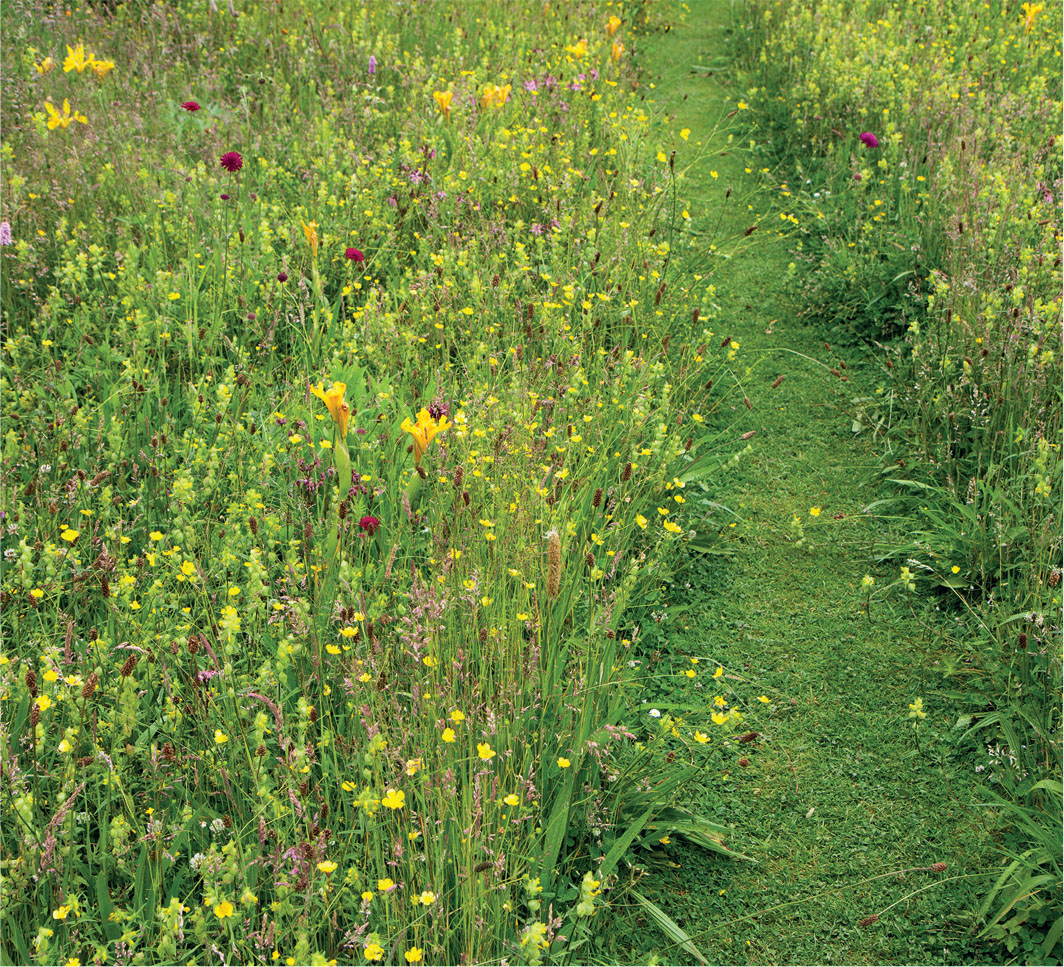
A path mown through your meadow is inviting, it keeps your feet dry after rain and dew, and you’ll find your Blackbirds use it as much as you do.
7. Year 2 onwards
Spring meadow Don’t mow until late June or early July. Then cut to 5cm, leaving the clippings to dry in situ for a few days so that they can shed their seed, and then remove and compost them. Mow every few weeks for the rest of the growing season (usually to late autumn), always removing the clippings.
Summer meadow Mow in late March/early April to 5cm and remove the clippings. Then leave until August or even September, and mow again to 5cm, and once again in late autumn if there has been some regrowth. Top up with a bit of Yellow Rattle seed if needed, which needs to be sown in autumn.
Mowing in both of these options may require a sickle or scythe (ideally) or failing that shears or a strimmer. Be mindful of frogs and other wildlife when you cut.
As I say, real meadows aren’t easy, but be brave, keep at it, experiment, and enjoy every success you have.
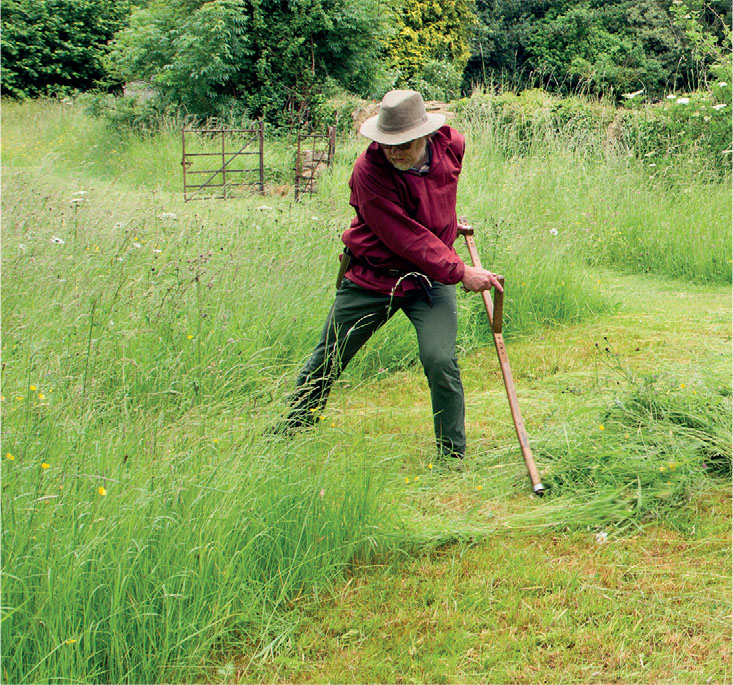
Richard Brown of the Scythe Association demonstrates how speedy and efficient mowing can be done the traditional, and quiet, way.
Meadow method 2: the liberated lawn
Difficulty level: Easy or very easy
If the thought of ripping up your lawn and digging down to subsoil is too much to contemplate, this solution, while not as rich in wildlife, will give you many of the benefits for a lot less pain, and a lot less time with the lawnmower!
This method is all about freeing your lawn from its usual prison sentence of repeated cutting. I’ve seen it done in gardens across the country, and it looks great.
1. For starters, just leave the mower in the shed for a month
This is the simplest technique, leaving the lawn uncut for a few weeks at some point in the summer. The grass will grow long and, in all likelihood, there will be some herbaceous plants tucked away among the grasses that will now get their turn in the limelight. Typical lawn ‘weeds’ include dandelions, Daisy, Self-heal, Black Medick and various speedwells. For a few glorious weeks, a whole wildlife community will delight in the mini jungle. Then resume your usual cutting routine.
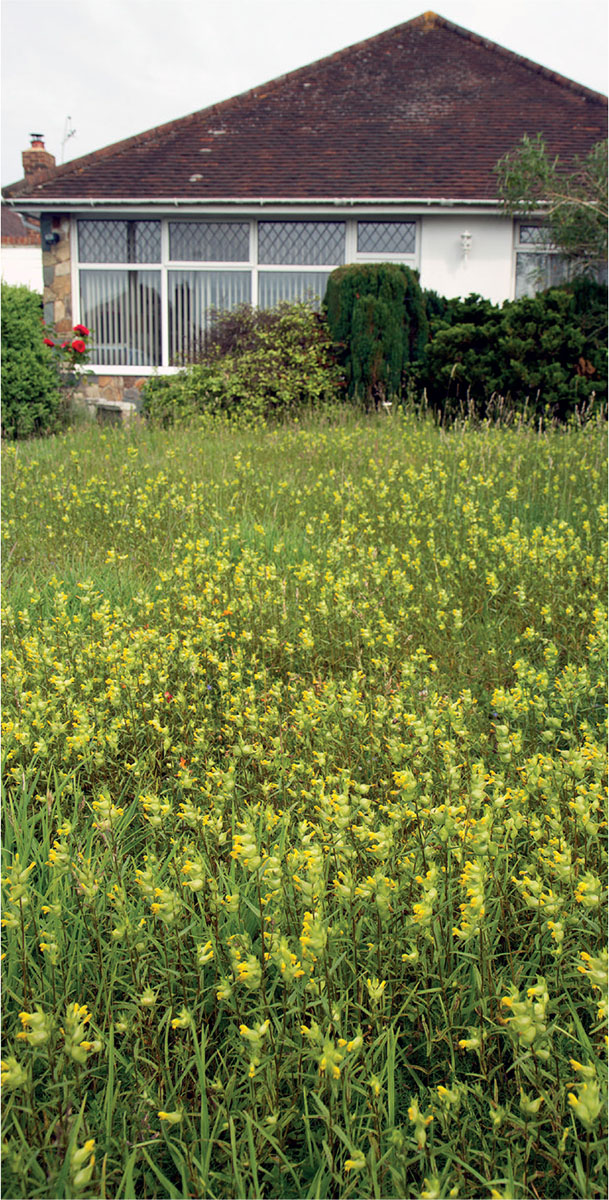
Here in Findon Valley, West Sussex, Simon Dannatt and Mark Taylor have used the ‘liberated lawn’ method to turn their back and front lawns into meadows. Without having to dig up the original lawn, but by reducing mowing and introducing Yellow Rattle seed, their lawns are now alive with bees in high summer.
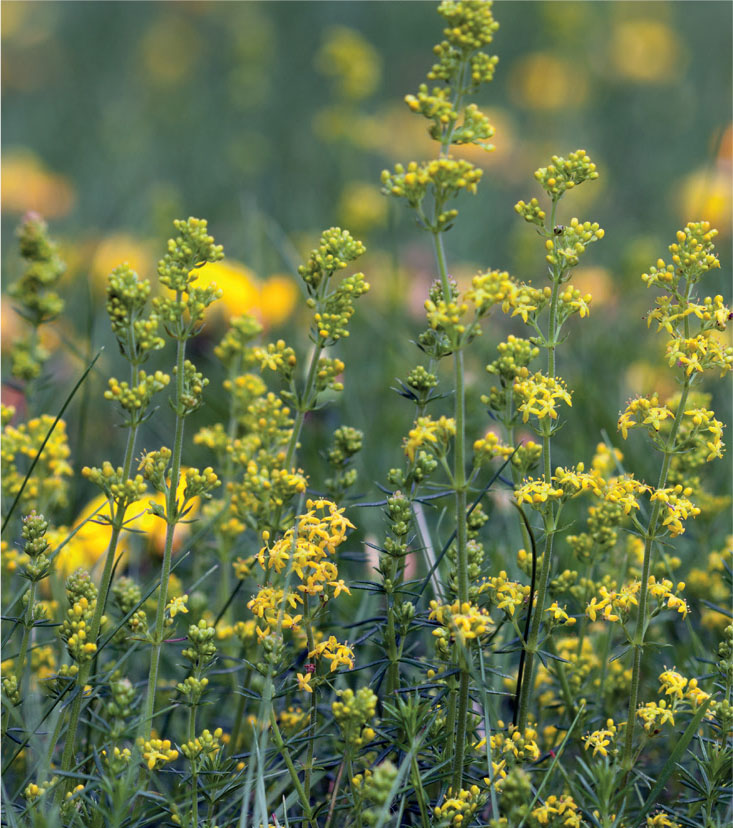
By adding a range of plug plants including Common Bird’s-foot Trefoil and (here) Lady’s Bedstraw, Simon and Mark have further increased the diversity of plants and hence wildlife.
2. Take it further, treat it like a real meadow
Adopt one of the following mowing regimes.
For a spring meadow, don’t mow at all until late June or early July. Then ‘mow’, leaving the clippings to dry in situ for a few days so that they can shed their seed, and then remove and compost them. This first mow may need to be with a sickle if the grass is too high for a lawnmower. Then mow every few weeks for the rest of the growing season (usually to late autumn), always removing the clippings.
For a summer meadow, mow in late March/early April with the mower raised to its highest setting, and remove the clippings. Then leave until August or early September, and mow again on highest setting, and once again in late autumn if there has been some regrowth.
3. With both of these options, resist all temptation to use fertilisers, top-dressings and weedkillers
Do rake out the thatch and moss if necessary, but always remove the grass cuttings. You are trying to reduce the fertility bit by bit, to allow the flowering plants a chance to compete against the vigorous grasses.
4. Spice it up with plug plants
It is certainly worth planting some low-growing meadow flowers as ‘plugs’ (young plants grown in individual modules). Top plants to try include Bird’s-foot Trefoil, Cowslip and Field Scabious.
5. Use the secret weapon – Yellow Rattle
Scratch the surface with a rake in autumn to create a mosaic of bare patches among the turf, and sprinkle with Yellow Rattle seed.
MAKING A LIBERATED LAWN LOOK LOVED
If it is the untidiness of a wildflower meadow that puts you off, there is a brilliant solution. All you need to so is impose some discipline by mowing neat lines around the edges of your meadow areas to create clearly defined shapes, and by cutting paths through the middle. Kids will love running along the paths, you’ll still save plenty of time, and it will clearly signal to anybody peering over the fence that you haven’t let things go and that you are most definitely in control in a rather daring and modern way!

With selective mowing, this is both a wildlife-friendly garden but also one that is clearly loved.
Flowers and grasses for wildflower meadows
Use this table to pick a mix of seeds that’s right for your garden and the type of meadow you want to have.

